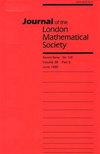黎曼ζ函数在临界线上的平方的相关性
IF 1.2
2区 数学
Q1 MATHEMATICS
Journal of the London Mathematical Society-Second Series
Pub Date : 2025-09-14
DOI:10.1112/jlms.70289
引用次数: 0
摘要
我们计算了Riemann zeta函数的两个移位平方乘积在临界线上的平均值,其移位的大小可达T³/2- ε $T^{3/2-\varepsilon}$。我们给出了这种平均值的显式表达式,并推导了误差项的近似谱展开,类似于Motohashi的。因此,我们还计算了Riemann zeta函数的(2,2)-矩,为此我们部分验证(并部分驳斥)了Bailey和Keating的一个猜想。本文章由计算机程序翻译,如有差异,请以英文原文为准。


Correlations of the squares of the Riemann zeta function on the critical line
We compute the average of a product of two shifted squares of the Riemann zeta function on the critical line with shifts up to size . We give an explicit expression for such an average and derive an approximate spectral expansion for the error term similar to Motohashi's. As a consequence, we also compute the (2,2)-moment of moment of the Riemann zeta function, for which we partially verify (and partially refute) a conjecture of Bailey and Keating.
求助全文
通过发布文献求助,成功后即可免费获取论文全文。
去求助
来源期刊
CiteScore
1.90
自引率
0.00%
发文量
186
审稿时长
6-12 weeks
期刊介绍:
The Journal of the London Mathematical Society has been publishing leading research in a broad range of mathematical subject areas since 1926. The Journal welcomes papers on subjects of general interest that represent a significant advance in mathematical knowledge, as well as submissions that are deemed to stimulate new interest and research activity.

 求助内容:
求助内容: 应助结果提醒方式:
应助结果提醒方式:


